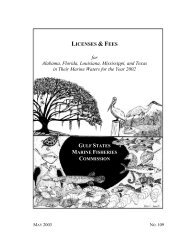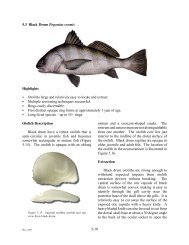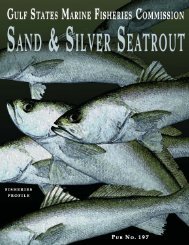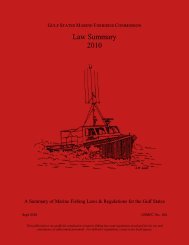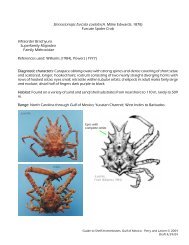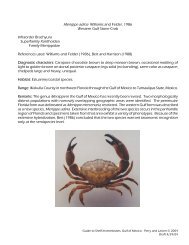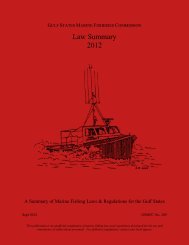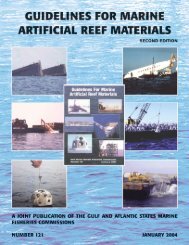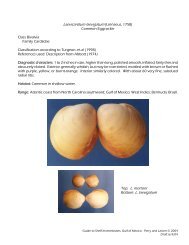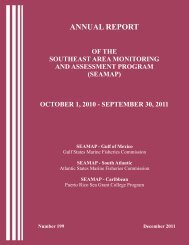MARINE DIRECTORY - Gulf States Marine Fisheries Commission
MARINE DIRECTORY - Gulf States Marine Fisheries Commission
MARINE DIRECTORY - Gulf States Marine Fisheries Commission
- No tags were found...
You also want an ePaper? Increase the reach of your titles
YUMPU automatically turns print PDFs into web optimized ePapers that Google loves.
2013 SEAMAP-GULF OF MEXICO<strong>MARINE</strong> <strong>DIRECTORY</strong>Fishery-Independent Survey ActivitiesSOUTHEAST AREA MONITORINGAND ASSESSMENT PROGRAMRead Hendon, ChairmanNumber: 213 February 2013
THIS <strong>DIRECTORY</strong> WAS SUPPORTED IN PART BY THENATIONAL OCEANIC AND ATMOSPHERIC ADMINISTRATION,NATIONAL <strong>MARINE</strong> FISHERIES SERVICE; STATE/ FEDERALPROJECT NUMBER NA11NMF4350028.
INTRODUCTIONThe Southeast Area Monitoring and Assessment Program (SEAMAP) is a cooperativeState/Federal/university program for the collection, management and dissemination of fisheryindependentdata (data collected without direct reliance on any commercial or recreationalfishery) and information in the Southeast region. Presently, there are three components to theprogram: the SEAMAP-<strong>Gulf</strong>, SEAMAP-South Atlantic and SEAMAP-Caribbean (Puerto Ricoand the U.S. Virgin Islands).This <strong>Marine</strong> Directory updates information contained in past SEAMAP <strong>Marine</strong> Directories, anddescribes survey activities (ongoing programs, vessel schedules, etc.) throughout the <strong>Gulf</strong> ofMexico. The program is managed through the <strong>Gulf</strong> <strong>States</strong> <strong>Marine</strong> <strong>Fisheries</strong> <strong>Commission</strong>’soffice.Agencies responding to the 2013 Directory were contacted in January 2013 and were requestedto provide current information or projected changes in their survey programs. Tables 1, 2, 3 and4 are condensed summaries of information submitted by responding agencies and organizations,indicated as either Federal, State, university activities, or non-profit organizations.Representatives of agencies contributing information to the current and past directories are listedalphabetically in Appendix A by organizational category. The SEAMAP Subcommittee wouldlike to express its appreciation to all organizations responding to the request for information.Other organizations conducting fishery-independent marine or estuarine surveys are encouragedto contact SEAMAP for inclusion in future listings. The Directory will be updated each year,with copies supplied to participating organizations and other interested people.Appendix B lists published documents which have been produced by the SEAMAP and areavailable through the <strong>Gulf</strong> <strong>States</strong> <strong>Marine</strong> <strong>Fisheries</strong> <strong>Commission</strong>. Questions and requests fordetailed information concerning the Directory or SEAMAP should be referred to:Jeffrey K. ResterSEAMAP-<strong>Gulf</strong> Coordinator<strong>Gulf</strong> <strong>States</strong> <strong>Marine</strong> <strong>Fisheries</strong> <strong>Commission</strong>2404 Government StreetOcean Springs, Mississippi 39564(228) 875-5912(228) 875-6604 FAXE-Mail: jrester@gsmfc.org
APPENDIX A<strong>MARINE</strong> AGENCY CONTACTS
FEDERAL AGENCIESU.S. DEPARTMENT OF COMMERCENOAA/National <strong>Marine</strong> <strong>Fisheries</strong> ServiceSoutheast <strong>Fisheries</strong> Science CenterDr. Bonnie Ponwith, Center Director75 Virginia Beach DriveMiami, Florida 33149(305) 361-4264, (305) 361-4219 FAXbonnie.ponwith@noaa.govDr. Theo Brainerd, Deputy Director75 Virginia Beach DriveMiami, Florida 33149(305) 361-4284, (305) 361-4219 FAXtheo.brainerd@noaa.govSustainable <strong>Fisheries</strong> DivisionDr. Clay Porch, Division Director75 Virginia Beach DriveMiami, FL 33149(305) 361-4232, (305) 361-4515 FAXclay.porch@noaa.govProtected Resources/Biodiversity DivisionDr. James Bohnsack, Division Director75 Virginia Beach DriveMiami, FL 33149(305) 361-4252, (305) 361-4478 FAXjim.bohnsack@noaa.gov<strong>Fisheries</strong> Statistics DivisionDr. Steve Turner, Chief75 Virginia Beach DriveMiami, FL 33149(305) 361-4482, (305) 361-4515 FAXsteve.turner@noaa.govGalveston LaboratoryDr. Roger Zimmerman, Laboratory Director4700 Avenue UGalveston, TX 77551-5997(409) 766-3500, (409) 766-3508 FAXroger.zimmerman@noaa.govMississippi LaboratoriesDr. Lisa Desfosse, DirectorPascagoula FacilityP.O. Drawer 1207Pascagoula, MS 39568-1207(228) 762-4591, (228) 769-9200 FAXlisa.desfosse@noaa.govDr. Christopher Gledhill, Branch ChiefStennis Space CenterSSC, MS 39529(228) 688-3104, (228) 688-1151 FAXchristopher.t.gledhill@noaa.govPanama City LaboratoryMr. Guy Davenport, Laboratory Director3500 Delwood Beach RoadPanama City, FL 32408(850) 234-6541 ext. 203, (850) 235-3559 FAXguy.davenport@noaa.govwww.sefscpanamalab.noaa.govBeaufort LaboratoryDr. Aleta Hohn, Laboratory Director101 Pivers Island RoadBeaufort, NC 28516(252) 728-8797; (252) 728-8784 FAXaleta.hohn@noaa.govNOAA/National <strong>Marine</strong> <strong>Fisheries</strong> Service/NOSCenter for Coastal <strong>Fisheries</strong> and Habitat ResearchDr. David Johnson, Center DirectorNational Ocean Service101 Pivers Island RoadBeaufort, NC 28516(252) 728-8746, (252) 728-8784 FAXdavid.johnson@noaa.govU.S. DEPARTMENT OF INTERIORBureau of Ocean Energy Management, Regulationand Enforcement (BOEMRE)<strong>Gulf</strong> of Mexico OCS RegionDr. Pasquale F. RoscignoMail Stop 54301201 Elmwood Park BoulevardNew Orleans, LA 70123-2394(504) 736-2752pasquale.roscigno@boemre.govDr. Alexis Lugo-FernandezLA/TX Shelf Physical Oceanography(504) 736-2593, (504) 736-2901 FAXalexis.lugo.fernandez@boemre.govU.S. Fish and Wildlife Service, Ecological ServicesMr. Allan M. Strandc/o TAMU Corpus Christi State UniversityCampus Box 3386300 Ocean DriveCorpus Christi, TX 78412(361) 994-9005, (361) 994-8262 FAXallan_strand@fws.govU.S. Geological Survey, Biological ResourcesDr. Gregory J. SmithNational Wetlands Research Center700 Cajundome BoulevardLafayette, LA 70506-3152(337) 266-8501, (337) 266-8610 FAXgregory_smith@usgs.govwww.nwrc.gov
U.S. DEPARTMENT OF DEFENSEDr. Susan Rees, PD-ECU.S. Army Corps of EngineersDepartment of DefenseP.O. Box 2288Mobile, AL 36628(251) 694-4141, (251) 690-2721 FAXsusan.i.rees@sam.usace.army.milNON-PROFIT ORGANIZATIONGULF AND SOUTH ATLANTIC FISHERIESFOUNDATION, INC.Ms. Judy Jamison, Executive Director5401 W. Kennedy BoulevardSuite 740Tampa, FL 33609(813) 286-8390, (813) 286-8261 FAXjudy.jamison@att.netTHE CONSERVANCY OF SOUTHWESTFLORIDA IN NAPLESDr. Dave Addison, Co-DirectorDr. Kathy Worley, Co-DirectorEnvironmental Science1450 Merrihue DriveNaples, FL 34102(239) 403-4230, (239) 403-4223 FAXdaddison@conservancy.orgkworley@conservancy.orgSANIBEL-CAPTIVA CONSERVATIONFOUNDATIONDr. Eric Milbrandt, Director<strong>Marine</strong> Laboratory900A Tarpon Bay RoadSanibel, FL 33957(239) 395-3115, (239) 395-4616 FAXemilbran@sccf.orgSTATE AGENCIESALABAMA DEPARTMENT OFCONSERVATION AND NATURALRESOURCESMr. John Mareska<strong>Marine</strong> Resources Division2 North Iberville DriveP.O. Box 189Dauphin Island, AL 36528(251) 861-2882; (251) 861-8741 FAXjohn.mareska@dcnr.alabama.govFLORIDA FISH AND WILDLIFECONSERVATION COMMISSION FISH ANDWILDLIFE RESEARCH INSTITUTEMr. Robert McMichael100 8th Avenue, S.E.St. Petersburg, FL 33701-5095(727) 896-8626, (727) 823-0166 FAXbob.mcmichael@myfwc.comLOUISIANA DEPARTMENT OF WILDLIFEAND FISHERIESMr. Myron FischerP.O. Box 33Grand Isle, LA 70358(985) 787-2163, (985) 787-4517 FAX;(985) 258-6006 CELLmfischer@wlf.la.govMISSISSIPPI DEPARTMENT OF <strong>MARINE</strong>RESOURCESMr. Dale Diaz1141 Bayview, Suite 101Biloxi, MS 39530(228) 523-4064 (228) 374-5220 FAXdale.diaz@dmr.ms.govTEXAS PARKS AND WILDLIFEDEPARTMENTMr. Fernando Martinez-AndradeNRC Building, Suite 25006300 Ocean Drive, UNIT 5845Corpus Christi, TX 78412-5845(361) 825-3028; (361) 825-3370 - FAXFernando.Martinez-Andrade@tpwd.state.tx.usUNIVERSITIESSEA GRANT PROGRAMSFlorida Sea Grant College ProgramDr. Karl E. Havens, DirectorDr. Charles Sidman, Associate Director for ResearchUniversity of FloridaP.O. Box 110400Gainesville, FL 32611-0400(352) 392-5870, (352) 392-5113 FAXkhavens@ufl.edu; csidman@ufl.eduMississippi-Alabama Sea Grant ConsortiumDr. LaDon Swann, Director703 East Beach BoulevardOcean Springs, MS 39564(228) 818-8841swanndl@auburn.eduwww.masgc.org
Louisiana Sea Grant College ProgramDr. Robert R. Twilley, Executive Director238 Sea Grant BuildingLouisiana State UniversityBaton Rouge, LA 70803-7507(225) 578-6445, 578-6331 FAXrtwilley@lsu.eduwww.laseagrant.orgTexas Sea Grant ProgramDr. Pamela Plotkin, DirectorTexas A&M University4115 TAMUCollege Station, TX 77845(979) 845-3854, (979) 845-7525 FAXplotkin@tamu.eduALABAMA UNIVERSITY PROGRAMSDauphin Island Sea LabDr. John Valentine, Executive Director101 Bienville BoulevardDauphin Island, AL 36528(251) 861-2141, (251) 861-7540 FAXjvalentine@disl.orgUniversity of AlabamaDr. Behzad Mortazavi<strong>Marine</strong> Sciences ProgramDISL101 Bienville BoulevardDauphin Island, AL 36528(251) 861-7528, (251) 861-7540 FAXbmortazavi@ua.eduTalladega CollegeDr. Alison Brown, Acting DirectorDepartment of Biology627 West Battle StreetTalladega, AL 35160(256) 761-6310alisonbrown@talladega.eduUniversity of South AlabamaDr. Sean PowersDepartment of <strong>Marine</strong> SciencesLife Sciences Building Room 25Mobile, AL 36688-0002(251) 460-6101, (251) 460-7357 FAXspowers@usouthal.eduFLORIDA UNIVERSITY PROGRAMSFlorida Institute of OceanographyDr. Jyotika Virmani830 First St., SouthSt. Petersburg, FL 33701(727) 553-1100, (727) 553-1109 FAXJyotika@usf.eduFlorida State UniversityDr. Robert LivingstonDepartment of Biological SciencesTallahassee, FL 32306(904) 644-4887, (904) 644-9829 FAXlivingston@bio.fsu.eduUniversity of FloridaDr. William J. LindbergDept. of <strong>Fisheries</strong> and Aquatic Sciencesst7922 NW 71 StreetGainesville, FL 32653-3071(352) 392-9617 ext. 239, (352) 846-1088 FAXwjlindber@mail.ifas.ufl.eduUniversity of South FloridaDr. Norman J. BlakeDepartment of <strong>Marine</strong> Science140 Seventh Avenue, SouthRoom MSL212St. Petersburg, FL 33701(727) 553-1521, (727) 553-1189nblake@marine.usf.eduhttp://www.marine.usf.edu/misc/facindex.htmlUniversity of MiamiDr. Nelson M. EhrhardtRosenstiel School of <strong>Marine</strong>and Atmospheric Science4600 Rickenbacker CausewayMiami, FL 33149(305) 361-4741, (305) 361-4600 FAXnehrhardt@rsmas.miami.eduUniversity of West FloridaDr. George StewartBiology Department11000 University ParkwayPensacola, FL 32514(850) 474-2748, (850) 474-2749 FAXgstewart@uwf.edu
LOUISIANA UNIVERSITY PROGRAMSLouisiana State UniversityDr. Richard F. Shaw, ProfessorDepartment of Oceanography & Coastal SciencesSchool of the Coast and EnvironmentBaton Rouge, LA 70803-6513(225) 578-6734, (228) 578-6513 FAXrshaw@lsu.eduNicholls State UniversityDr. Earl MelanconDepartment of Biological SciencesThibodaux, LA 70310(985) 448-4689; 493-2496 - FAXearl.melancon@nicholls.eduLouisiana Universities <strong>Marine</strong> Consortium(LUMCON)Dr. Nancy Rabalais, Executive Director8124 Highway 56Chauvin, LA 70344(985) 851-2801; 851-2874 FAXnrabalais@lumcon.eduUniversity of Louisiana - LafayetteDr. Darryl Felder, ProfessorDepartment of Biology251 Billeaud Hall, Box 42451Lafayette, LA 70504-2451(337) 482-6753, (337) 482-5834dfelder@louisiana.eduMISSISSIPPI UNIVERSITY PROGRAMSThe University of Southern Mississippi<strong>Gulf</strong> Coast Research LaboratoryDr. Eric Powell, Director<strong>Gulf</strong> Coast Research Laboratory703 East Beach DriveOcean Springs, MS 39564(228) 818-8810, (228) 818-8848 FAXeric.n.powell@usm.eduhttp://www.usm.edu/gcrlTEXAS UNIVERSITY PROGRAMSThe University of Texas-Pan AmericanDr. Thomas Whelan III, DirectorCoastal Studies Laboratory100 <strong>Marine</strong> Lab DriveSouth Padre Island, TX 78597(956) 761-2644; (956) 761-2913 FAXtwhelan3@utpa.eduhttp://www.utpa.edu/dept/csl/csl.htmlTexas A & M University at GalvestonDr. André M. Landry, Jr.Department of <strong>Marine</strong> BiologyInstitute of <strong>Marine</strong> Life SciencesP.O. Box 1675Galveston, TX 77553-1675(409) 740-4889, (409) 740-5001 FAXlandrya@tamug.eduTexas A & M University - KingsvilleDr. John C. PérezRegents Professor of Biology and Director of theNatural Toxins Research Center NTRCMSC 158975 W. Avenue BKingsville, TX 78363-8202(361) 593-3805; (361) 593-3798 FAXkfjcp00@tamuk.eduUniversity of HoustonDr. Dan Wells, ChairDepartment of Biology and Biochemistry369 Science and Research Building 2Houston, TX 77204(713) 743-2644dwells@uh.eduThe University of Texas at AustinDr. W. Arthur Porter, Acting Director<strong>Marine</strong> Science Institute750 Channel View DrivePort Aransas, TX 78373-5015(361) 749-6730, (361) 749-6777 FAXsporter@cns.utexas.eduTexas A&M University at Corpus ChristiDr. Larry McKinney, DirectorHarte Research Institute for <strong>Gulf</strong> of Mexico Studies6300 Ocean Drive, HRI 318DCorpus Christi, TX 78412(361) 825-2070, (361) 825-2050 FAXlarry.mckinney@tamucc.eduhttp://www.harteresearchinstitute.org
TABLE 1. SUMMARY OF INFORMATION PROVIDED BY FEDERAL AGENCIESTYPES OF FISHERY-INDEPENDENT SAMPLINGANNUAL EFFORT DEVOTEDTO FISHERY-INDEPENDENTSAMPLINGBY ACTIVITY IN:TYPES OF GEARAGENCYTARGETSPECIESLIFE STAGESSAMPLEDAREASAMPLEDGEOGRAPHICAREAS OFIMPORTANCETYPES OFPLATFORMSNUMBEROF DAYSNUMBER OFSTATIONSTRAWLING, PLANKTON, TRAPS, ETC.SAMPLESTRATEGY FORDATACOLLECTIONSTATUS OFFISHERY-INDEPENDENTSURVEYSOVER NEXT 5YEARSSPECIESPRESENTLYUNABLE TOSAMPLENOAA/NMFS/SEFSCMississippi LabsBottomfish/ shrimp;pelagic withplanktonic stagesSubadults-adults;eggs/larvae<strong>Gulf</strong> of Mexico(Alabama to Texas)Territorial170' OREGON II and224' GORDONGUNTER121 sea days trawling;plankton inconjunction with trawlsurveys720 trawl; 100plankton and 530environmental40' semiballoon, 90' high opening bottom trawl,Bongo array w/ .333-mm mesh nets; 1x2-mneuston w/ .950-mm mesh netsTrawling-randomstratified 5-60 fm;plankton-systematicgrid out to 100 fmContinuationAdult fish ofmany species(cobia, mullet,black drum, etc.)Reef fish (snapper,grouper)Subadults-adults <strong>Gulf</strong> of Mexico Territorial OREGON IIGORDON GUNTERCARETTA, andGANDY101 sea days 400 trap/video camera;60 ROV drops;environmentalTraps/video camera; ROVTraps and longlinerandomstratified, 5to 100 fmContinuationNone<strong>Marine</strong> mammals(dolphins & whales)Juveniles/adults<strong>Gulf</strong> of Mexico/CaribbeanTerritorial; open ocean(EEZ); Puerto Rico toVirgin IslandsGORDON GUNTER 69 sea days Approximately 750sightings, 200 biopsiesand environmental dataat sightingsVisual with bigeye binoculars; cross bow,taggingMammals-linetransectContinuationNoneAll species withplanktonic stages(primarily Bluefin,Mackerel and RedDrum) ofcommercial andrecreationalimportanceEggs/larvae/juveniles<strong>Gulf</strong> of MexicoTerritorial; open ocean(EEZ)OREGON II andGORDON GUNTER76 sea days 832 plankton and 396environmentalBongo array w/ .333-mm mesh nets; 1x2-mneuston w/ .950-mm mesh netsPlankton - systematicgridContinuationSpring andsummer shelfspawners;summer, fall andwinter open <strong>Gulf</strong>spawnersCoastal Sharks; RedSnapperJuveniles/subadults-adultsSoutheast Atlantic and<strong>Gulf</strong> of MexicoTerritorial OREGON II 60 sea days 300 longline andenvironmentalMonofiliment bottom longline with 100 hooksper set, tagging sharksSharks/Snapper -random and statisticalzone in SouthAtlantic and <strong>Gulf</strong>, 5to 200 fmContinuationPelagic sharksMiami Lab (FL)All recreationally &commerciallyimportant species;reef fish; mackerelsLarvae; juveniles;adults<strong>Gulf</strong> of Mexico; SW &SE FLTerritorial; open ocean(EEZ)Ship support providedby Pascagoula Lab120/yr 3500/yr Fish traps; Bongo nets 60 & 20-cm w/ .333-mmmesh; neuston 1x2-m w/ .947-mm meshSystematic, gridbasis; long-termstation selection;estuary entrances;reefsFunding has beencut and may befurther reducednext FY.Billfishes; tunas;sharks
TABLE 1. (CONTINUED)TYPES OF FISHERY-INDEPENDENTSAMPLINGANNUAL EFFORT DEVOTED TOFISHERY-INDEPENDENT SAMPLINGBY ACTIVITY IN:TYPES OF GEARAGENCYTARGETSPECIESLIFE STAGESSAMPLEDAREASAMPLEDGEOGRAPHICAREAS OFIMPORTANCETYPES OFPLATFORMSNUMBEROF DAYSNUMBER OFSTATIONSTRAWLING, PLANKTON, TRAPS ETC.SAMPLESTRATEGY FORDATACOLLECTIONSTATUS OFFISHERY-INDEPENDENTSURVEYSOVER NEXT 5YEARSSPECIESPRESENTLYUNABLE TOSAMPLEGalveston Lab (TX)Penaeid shrimp;bottomfish; estuarinedependent spp.Postlarvae-adults <strong>Gulf</strong> of Mexico Internal; (EEZ) Ship support providedby Pascagoula Lab,Bay boats257/yr Varies Otter trawls 10'-40'; beam trawl; drop sampler Random stratified forTX Closure; longtermstudies forestuarine ecologyNoneNoneSea turtles Juveniles-adults <strong>Gulf</strong> of Mexico Internal; EEZ (oil & gasplatforms)Bay boats; helicopters;crew boats; satellitezodiac;12/yr45/yr96Varies60' - 80' Otter trawls RandomRandomNoneNoneNoneNoneKemp's ridley seaturtlesHatchlingsyearlings<strong>Gulf</strong> of Mexico (releaseof tagged turtles)Territorial; EEZ (Texas)U.S. Coast GuardCutter; R/VLONGHORN2Varies1-2 releases/yr10-20 turtlesSatellite; Geographic trackingNoneNoneNoneNoneNoneNoneSea turtlesStranded juvenilesadultsSW LA; TX Coastal beaches ATVs; dirt bikes;outboard boats50 Varies None Twice-monthlystratified randomsampling by beachstrataNoneNoneSea turtles Juveniles, Adults TX, LA Coastal shelf Satellite Varies 10-20 turtles Satellite Geographic Tracking Continuation NonePanama CityLab (FL)Sharks Juvenile/adults NE <strong>Gulf</strong> of Mexico Inshore Small boats, OREGONIIVariable Variable Gillnets & Longlines Systematic grid Continuation NoneReef Fish/Groupers Adults/larvae NE <strong>Gulf</strong> of Mexico 40 fm contour offApalachicola andFlorida ShelfGORDON GUNTER Variable Variable Hydroacoustics/ROV; 1x1 m Tucker Trawl(.333 mm mesh)/1x2 m neuston 0.547 mmmesh) TrapsSpawningaggregation &systematic transectsContinuationNoneGroupers andsnappersJuveniles NE <strong>Gulf</strong> of Mexico Inshore; Seagrassmeadows of WestFlorida ShelfSmall boats Variable Variable 16' trawl/crab scrape; neuston/push net systematic stations FundingDependentNoneCoral RestorationPresently South AtlanticOculina banksFERREL andOREGON IIVariableVariableTraps, ROV, Exp. SubstratesOnsiteContinuationNoneBeaufort Lab (NMFS)Reef fishsnappers/groupersAdults, juvenilesTortugas EcologicalReservesMPAsSmall boats, divecharters6/yr24Visual census; splitbeam sonarSpawningaggregation; randomtransectsFundingdependentNone of targeted
TABLE 2. SUMMARY OF INFORMATION PROVIDED BY STATE AGENCIESTYPES OF FISHERY-INDEPENDENTSAM PLINGANNUAL EFFORT DEVOTED TOFISHERY-INDEPENDENTSAM PLINGBY ACTIVITY IN:TYPES OF GEARAGENCYTARGETSPECIESLIFE STAGESSAMPLEDAREASAMPLEDGEOGRAPHICAREAS OFIMPORTANCETYPES OFPLATFORMSNUMBEROF DAYSNUMBER OFSTATIONSTRAWLING, PLANKTON, TRAPS, ETC.SAMPLESTRATEGY FORDATACOLLECTIONSTATUS OFFISHERY-INDEPENDENTSURVEYSOVER NEXT 5YEARSSPECIESPRESENTLYUNABLE TOSAMPLEFLORIDA FISHAND W ILDLIFECONSERVATIONCOM M ISSIONAll estuarinefishes, groupers,snappers, bluecrab, stone crab,spiny lobster,hard clams,scallopsAll stagesFL waters &offshoreInternal; territorial;EEZNumerous 22'-26'outboards, 36' BrunoVaries Varies 40' SEAM AP trawl, 20' trawl, 600'seines, various size beach seines, gillnets, visual counts, underwater video,lobster & crab trapsSystematic,stratified randomgrid based, longtermstationselection, shorttermspecialstudiesContinuedinshore ascurrentlycompleted,increasegrouper andsnappersamplingM ackerel,cobia,amberjackALABAM ADEPARTM ENTOFCONSERVATIONAND NATURALRESOURCESAll penaeidshrimp; southernflounder; <strong>Gulf</strong>menhaden; reddrum; redsnapper; bluecrab; black drum;Spanish mackerel;striped mullet;spotted sea trout;oystersLarvae-adultsAL marshes toterritorial sea; EEZIntertidal; territorial;EEZ22' Tiara, (2) 90-hp;25' Parker (2), 150-hp; 27' Endurance,(2) 200-hp; 21'Buskins 150-hp; 23’gillnet boat, 150-hp;65' R/V AlabamaDiscovery80/yr Varies 50' bag seine; 16' otter trawl; 40'SEAM AP trawl; variable mesh gill net; 6'beam plankton trawl; neuston; oysterdredge; vertical and bottom longlineLong-term stationselection, effortvaries according tospawning seasonof target speciesmonitoring reeffish populations atrandomly selectedreef sitesIncrease effortto determine yrclassstrength oftarget species;conduct moreage & growthwork; exploremeans tosample offshorereef fish areasNoneM ISSISSIPPIDEPARTM ENTOF M ARINERESOURCESAll penaeidshrimp; oysters;sciaenids;flounder; bluecrrabsJuveniles-adults M S territorial sea Internal; territorial;EEZ28' outboard;18' outboard;24' outboard;65' oyster dredgeboat; 35’ outboard;23' skiff; 22'outboard; 32' oystervessel jet drive; 19'outboard 150-hpoyster; 24' outboard150-hp oyster; 34'outboard 2 (250-hp)shrimp; 43' artificialreef vessel in-boardengine50/yr10/yr50-60/yrVaries;6/mo (oyster) & 10-36/mo (shrimp)varies16' trawl; oyster tongs & dredge; gill net,drop samplerLong-term stationselection, varies w/opening & closingof areas; randomgrid sampling;sample night timerecreational fishingIncreasetaggingactivities; age &growth work;seasonalabundanceJuvenile RedSnapper
TABLE 2. (CONTINUED)TYPES OF FISHERY-INDEPENDENTSAM PLINGANNUAL EFFORT DEVOTED TOFISHERY-INDEPENDENTSAM PLINGBY ACTIVITY IN:TYPES OF GEARAGENCYTARGETSPECIESLIFE STAGESSAMPLEDAREASAMPLEDGEOGRAPHICAREAS OFIMPORTANCETYPES OFPLATFORMSNUMBEROF DAYSNUMBER OFSTATIONSTRAWLING, PLANKTON, TRAPS, ETC.SAMPLESTRATEGY FORDATACOLLECTIONSTATUS OFFISHERY-INDEPENDENTSURVEYSOVER NEXT 5YEARSSPECIESPRESENTLYUNABLE TOSAMPLELOUISIANADEPARTM ENTOF W ILDLIFE &FISHERIESAll penaeidshrimp; blue crab;finfish; oystersLarvae to adultsLA inshore waters;territorial seas; EEZInternal; territorial 17' outboard; 30'inboard; leasedvessel (SEAM AP)State: 167;SEAM AP: 15Trawls:800128849472181Finfish:860978246Oyster:135267Plankton:1242121Trawls:6' (inshore);16' (inshore);16' (offshore);40' (inshore);Hex M esh Trap Finfish:Finfish:50' bag seine;gill net;trammel net;Oyster:square meter;Dredge;Plankton:1/2-m ring (.153-mm);60cm bongo (.363-mm);1x2m neuston (.948-mm)Long-term fixedstations; stratifiedrandom stations(SEAM AP)Increaseterritorial seasampling;increaseemphasis onfinfishAdult pelagicfinfish inopen <strong>Gulf</strong>watersTEXAS PARKSAND W ILDLIFEDEPARTM ENTAll penaeidshrimp; all otherspeciesJuveniles- adultsTX internal coastalwaters; territorial seaInternal; territorial30'-55' inboards;18'-25' outboards;skiffs365/yr2160/yr1680/yr960/yr780/yr1080/yr600' bag seines; 20' trawl (inshore); 20'trawl (offshore); 600' gill nets; oysterdredgeLong-termstratified randomstations, gridbasedContinue efforton internalcoastal waters;increase efforton territorial seawith emphasison adult finfishAdult finfishin open <strong>Gulf</strong>waters
TABLE 3. SUMMARY OF INFORMATION PROVIDED BY UNIVERSITIESTYPES OF FISHERY-INDEPENDENTSAM PLINGANNUAL EFFORT DEVOTED TOFISHERY-INDEPENDENTSAM PLINGBY ACTIVITY IN:TYPES OF GEARAGENCYTARGETSPECIESLIFE STAGESSAMPLEDAREASAMPLEDGEOGRAPHICAREAS OFIMPORTANCETYPES OFPLATFORMSNUMBEROF DAYSNUMBER OFSTATIONSTRAWLING, PLANKTON, TRAPS, ETC.SAMPLESTRATEGY FORDATACOLLECTIONCHANGES OFFISHERY-INDEPENDENTACTIVITIESOVER NEXT 5YEARSHIGHPRIORITYSPECIESPRESENTLYUNABLE TOSAMPLEFLORIDAFLORIDA STATEUNIVERSITYBenthic infauna;epibenthic fishes &invertebratesLarvae-adults NE <strong>Gulf</strong> of Mexico Internal; territorial 55-hp 25' skiffs;outboard48/yrMonthly samples, bothtrawl & environmentalStandard 5-m otter trawl; 80-um plankton netSystematic, randomlong-term stationselection; short-termspecial studiesMoreenvironmentalexperimentationApalachicola &Apalachee Bay;and all species inthose areasUNIVERSITY OFWEST FLORIDADemersalvertebrates &invertebratesSubadults-adults NE <strong>Gulf</strong> of Mexico Estuarine 14' and 16' skiff; 22'center consoleVaries50/yr140/yr180/yr16' otter trawl; 1-m bongos; 1-m neuston Systematic, random(stratified) visualsurveyMoreenvironmentalassessmentFLORIDA SEAGRANTAll species All stages <strong>Gulf</strong>; Caribbean; SouthAtlanticInternal; territorial No vessels owned -Depends on projectVaries Varies Varies Varies More recruitment NoneFLORIDA INSTITUTEOF OCEANOGRAPHYAll species All stages <strong>Gulf</strong>; Caribbean; SouthAtlanticInternal; territorialSUNCOASTER;BELLOWS20-30/project Varies 40' otter trawl; tucker trawl; shellfish dredge;Various plankton netsRandom, long-termstation selection;short-term specialstudiesTo continue w/SEAMAP;expandedenvironmentalsamplingNoneUNIVERSITY OFFLORIDAReef fishes,epibenthicinvertebrates, &benthic macrofaunaJuvenile to adults Eastern <strong>Gulf</strong> of Mexico Shallow ContinentalShelfTwo 24' dive boats, 33'trawler160/yr192 visual fishsamples/yr 672benthic cores/yrOtter trawlRandomizedsampling ofexperimentalreplicatesIncreaseexperimentalreplicates & adddisciplines &zooplanktonPrimaryproducersUNIVERSITY OFMIAMIAll species All stages <strong>Gulf</strong>; Caribbean; SouthAtlanticEstuarine; offshore;inshoreOffshore: COLOMBUSISELIN; inshore:CALANUS; estuarine:25' I/O240/yr;200/yr;150/yrVaries;Varies;VariesHydroacoustics; Various plankton nets Varies MorehydroacousticsNone
TABLE 3. (CONTINUED)TYPES OF FISHERY-INDEPENDENTSAM PLINGANNUAL EFFORT DEVOTED TOFISHERY-INDEPENDENTSAM PLINGBY ACTIVITY IN:TYPES OF GEARAGENCYTARGETSPECIESLIFE STAGESSAMPLEDAREASAMPLEDGEOGRAPHICAREAS OFIMPORTANCETYPES OFPLATFORMSNUMBEROF DAYSNUMBER OFSTATIONSTRAWLING, PLANKTON, TRAPS, ETC.SAMPLESTRATEGY FORDATACOLLECTIONSTATUS OFFISHERY-INDEPENDENTSURVEYSOVER NEXT 5YEARSSPECIESPRESENTLYUNABLE TOSAMPLEALABAM ADAUPHIN ISLANDSEA LABOysters; blue crab Larvae-adult Mobile Bay; east MSSoundEstuarine 26'-42' reseach vessels Biweekly; 48 hourtime seriesHundreds Clark-Bumpus zooplankton Distribution patterns;settle-ment factorsNoneNoneUNIVERSITY OFSOUTH ALABAMASciaenids; hardclam; blue crab; redsnapperLarvae-adultShelf & mouth ofMobile Bay; NW FL;east ALShelf; estuaries;grassbeds21' skiffs50"R/V22/24 episodic/mo12/yearSeveral hundred Fishing; surface; demersal Environmentalimpact/growth rate;Tag/ReleaseShift towardmanagementapplicationNoneMISSISSIPPI-ALABAMA SEAGRANTCONSORTIUMGeneralVertebrates: larvae;invertebrates: allstagesNorthern <strong>Gulf</strong> ofMexico; MS Sound;Mobile BayTerritorial; EEZ;estuarine; coastal96' TOMMYMUNRO; skiffs;industryVariesVariesCrab pots; tongs; closed, recirculating seawatersystem; opening/ closing plankton trawl; Blocknets/seine Various Plankton NetsVariesNoneNoneEstuarine fishspeciesJuvenile-subadultWeeks Bay, ALEstuarine14' skiffs60/yr180/yrRandom,concentrated in May,June & SeptemberNoneNoneM ISSISSIPPIUNIVERSITY OFSOUTHERNMISSISSIPPI/COLLEGE OF<strong>MARINE</strong>SCIENCES/GULFCOAST RESEARCHLABORATORYAll estuarine finfish;All penaeid shrimp;blue crab; croaker;spot; seatrout;catfish; <strong>Gulf</strong>menhanden; mullet;Atl. bumper;butterfish;cutlassfish; reddrum; squid; golden<strong>Gulf</strong> crabs/red crabs;jellyfishAll stagesMS estuarine; northern<strong>Gulf</strong>; Biloxi Bay; MSterritorial sea; offshoreto 2000 m; sargassum ascritical habitatEstuarine; territorial;EEZVarious small skiffs;96' TOMMYMUNRO; 20' - 30'outboards; 55' TOMMCILWAIN; 40'HERMES; 128' IX508(ROV support)Varies Varies Standard basic equipment; 50' bag seine; 16' &36' otter trawl; 6' Renfro beam trawl; variablemesh gill net; 40' shrimp trawl; 80' high-risenet; crab traps; standard basic equipment forhydrologic sampling; Tucker trawl; neuston;bongo; Benthos ROV; Seabird CTDShort-term specialstudies; Stratified,random long-termstation selection;fixed station longtermIncreasedevelopment ofmarine & coastalbiology program;Expansion ofmonitoring &assessment iffunds becomeavailable; longlinefor pelagic fishes;bottom longlining;deepwatertraps for crabs;monitoring ofessential fishhabitatNoneMISSISSIPPI-ALABAMA SEAGRANTCONSORTIUMGeneralVertebrates:juveniles;invertebrates: allstagesNorthern <strong>Gulf</strong> ofMexico; MS Sound;Mobile BayTerritorial; EEZ;estuarine; coastal96' TOMMYMUNRO; skiffsVaries Varies Varies; Various Plankton Nets Varies None None
TABLE 3. (CONTINUED)TYPES OF FISHERY-INDEPENDENTSAM PLINGANNUAL EFFORT DEVOTED TOFISHERY-INDEPENDENTSAM PLINGBY ACTIVITY IN:TYPES OF GEARAGENCYTARGETSPECIESLIFE STAGESSAMPLEDAREASAMPLEDGEOGRAPHICAREAS OFIMPORTANCETYPES OFPLATFORMSNUMBEROF DAYSNUMBER OFSTATIONSTRAWLING, PLANKTON, TRAPS, ETC.SAMPLESTRATEGY FORDATACOLLECTIONSTATUS OFFISHERY-INDEPENDENTSURVEYSOVER NEXT 5YEARSSPECIESPRESENTLYUNABLE TOSAMPLELOUISIANAUNIVERSITY OFNEW ORLEANSBlue crab; oyster;marine commercialfinfishAll stagesLake Pontchartrain;Lake BorgneEstuarine Varies Short-term specialstudiesAnalyzecommercial fishpopulations usingelectrophoresis;studies of oysternutrition ¶sitologyNoneNICHOLLS STATEUNIVERSITYOystersPost-Settlement(juvenile to adult)Barataria Bay Estuarine 24' bay boat 26-30 days (monthlyto bi-weekly)5 Oyster dredgesample Systematic/transect Minimum of nexttwo yearsNoneUNIVERSITY OFLOUISIANA -LAYFAYETTEStone crab; penaeidshrimp; commercialfinfishAll stagesNorthern <strong>Gulf</strong> ofMexicoCoastal; estuarineVarious LUMCONvessels (PELICAN,ACADIANA, skiffs)Varies Varies Trawl; dredge; traps; pots; seines Varies by population None NoneLOUISIANA STATEUNIVERSITYEstuarine & marinefinfish species;decapod crustaceansAll stagesBarataria, Terrebonne &Timbalier Bay; LakePontchartrain; MS Rivermouth; AtchafalayaEstuarine; territorialSmall skiffs;PELICAN;ACADIANA; oil &gas structuresVaries monthly Varies Drop BOX sampler; gill net; hydro-acousticstrawl; MOCNESS opening & closing bongonets; general plankton nets, light trapsShort-term specialstudies; long-termstations; tidaltransport & recruitmentEstimate fishabundance &movement usinghydroacoustics;examine growthrates &reproductivebiology ofimportantestuarine species;recruitment studiesNoneLOUISIANAUNIVERSITIES<strong>MARINE</strong>CONSORTIUMZooplankton;benthos; bottomfish;anchoviesAll stagesTerrebonne & TimbalierBay; inner continentialshelfEstuarine; coastal116' R/V PELICAN;58' R/V ACADIANA;small outboardsVaries Varies 5-m otter trawl; .333 & .505 mesh; generalplankton netsFixed station,transects, variesNoneNone
TABLE 3. (CONTINUED)TYPES OF FISHERY-INDEPENDENTSAM PLINGANNUAL EFFORT DEVOTED TOFISHERY-INDEPENDENTSAM PLINGBY ACTIVITY IN:TYPES OF GEARAGENCYTARGETSPECIESLIFE STAGESSAMPLEDAREASAMPLEDGEOGRAPHICAREAS OFIMPORTANCETYPES OFPLATFORMSNUMBEROF DAYSNUMBER OFSTATIONSTRAWLING, PLANKTON, TRAPS, ETC.SAMPLESTRATEGY FORDATACOLLECTIONSTATUS OFFISHERY-INDEPENDENTSURVEYSOVER NEXT 5YEARSSPECIESPRESENTLYUNABLE TOSAMPLETEXASUNIVERSITY OFTEXAS, <strong>MARINE</strong>SCIENCEINSTITUTEShelf & bay species All stages Internal; territorialwatersInternal; territorial 105' LONGHORN; 57'KATY; shallow-draftbay boats100/yr Varies 42' semiballoon shrimp trawl; 40' semiballonotter trawl; 12' x 24" plankton netShort-term specialstudiesInstitute expansionon all presentprogramsNoneTEXAS A&MUNIVERSITY -KINGSVILLEAll inshore bayspeciesAll stagesCorpus Christi toBrownsvilleInternal; coastal 24/yr 150/yr Short-term specialstudiesNoneNoneTEXAS A&MUNIVERSITYAll macrocrusteceans& finfishAll stages NW <strong>Gulf</strong> off LA & TX Internal; territorial 71' EXCELLENCE II;47' ROMIN EMPIREVaries Varies 34' & 50' semi-balloon trawls; Bongo net w/.333-mm & .505-mm meshShort-term specialstudiesNoneNoneTEXAS A&MUNIVERSITY -CORPUS CHRISTIAll species, shelf andbayAll stages Sabine to Brownsville Flower Gardens area;Corpus Christi; andLaguna MadreOffshore oil and gasplatforms; shallow bayboatsVaries Varies Gill nets; seines; other trawls; Scuba fish counts;Small, bays onlyBoth short-termspecial, and longterm;diving fishcountsNoneNoneUNIVERSITY OFTEXAS-PANAMERICANAll finfish & benthicmacrofauna ofLaguna Madre;All stagesCorpus Christi toBrownsvilleLaguna Madre; <strong>Gulf</strong>inshoreShallow-draft bayboats48/yrBiweekly & monthlydepending on projectOtter trawls & bag seines; Plankton towsLong-term baselinestudiesIntensive studiesof individualspeciesNone
TABLE 4. NON-PROFIT ORGANIZATIONSTYPES OF FISHERY-INDEPENDENTSAM PLINGANNUAL EFFORT DEVOTED TOFISHERY-INDEPENDENTSAM PLINGBY ACTIVITY IN:TYPES OF GEARAGENCYTARGETSPECIESLIFE STAGESSAMPLEDAREASAMPLEDGEOGRAPHICAREAS OFIMPORTANCETYPES OFPLATFORMSNUMBEROF DAYSNUMBER OFSTATIONSTRAWLING, PLANKTON, TRAPS, ETC.SAMPLESTRATEGY FORDATACOLLECTIONSTATUS OFFISHERY-INDEPENDENTSURVEYSOVER NEXT 5YEARSSPECIESPRESENTLYUNABLE TOSAMPLETHECONSERVANCYOF SOUTHW ESTFLORIDA INNAPLESAll fish speciesespecially spottedseatrout; seaturtles,mangroves, andmanateesAll stagesexcluding larvaeSoutheastern <strong>Gulf</strong> ofM exicoEstuaries; reefs;mangroves;nearshore; beaches35 hp, 19' skiff; 185hp, 20' flats boat;twin 50 hp, 25'barge100/yrVarieshook-and-line; dip nets; beach seinesVisual surveys,stratified, transectsAnticipate moreunderwatervisual surveys,hook-and-linetagging studiesfor seatrout,behavioralstudies ondolphins usingphotographyProgram tophotographdolphins isjust beginningbut are unableto samplemore than 10miles offshorewith currentcapabilitiesSANIBEL-CAPTIVACONSERVATIONFOUNDATIONSeagrasses,benthicvertebrates andinvertebrates,mangroves, andestuarine fishesAll stagesChiefly marine andestuarine habitatsaround Sanibel andCaptiva IslandsEstuaries, beaches,and artificial reefs25', 23', 17', 16',and 14'boats/trailerable150/yr8 multi-disciplinary,annually; others asper project12' otter trawl, 180' seine, 70' seine(FM RI/FIM standards)Stratified random,haphazard, fixedstationIncrease in thenumber ofFM RI/FIMstationsLarge pelagicfishes, mamals
APPENDIX BSEAMAP DOCUMENTS
SEAMAP DOCUMENTS LIST, 1982 - CURRENT1) SEAMAP Strategic Plan, January 1981. The initial planning document describing the intent todevelop the SEAMAP Program and outlining the preliminary goals and objectives, assessmentrequirements and priorities, research strategies, and funding requirements.2) SEAMAP Quick-Reports (Data Summaries): six summaries, June-July 1981; seven summaries,June-July 1983; seven summaries, June-July 1984; five summaries, June-July 1985; fivesummaries, June-July 1986; six summaries, June-July 1987; five summaries, June-July 1988;six summaries, June-July 1989; six summaries, June-July 1990; five summaries, June-July 1991;six summaries, June-July 1992; six summaries, June-July 1993; six summaries, June-July 1994;and six summaries, June-July 1995; six summaries, June-July 1996; six summaries, June-July1997; one summary, June 1998; seven summaries, June 2000; six summaries, June-July 2001;seven summaries, June-July 2002; seven summaries, June-July 2003, seven summaries, June-July 2004, seven summaries, June-July 2005; six summaries, June-July 2006, seven summaries,June-July 2007; six summaries, June-July 2008; six summaries, June-July 2009; sevensummaries, June-July 2010; seven summaries, June-July 2011; and seven summaries, June-July2012. Summaries of catch rate information from the SEAMAP Summer Shrimp/Groundfishsurveys (Squid/Butterfish Survey, 1985 only) in the northern <strong>Gulf</strong> of Mexico, indicating stationssampled, catch rates, assessment of shrimp and finfish yields, and synopses of hypoxicconditions in the survey areas. One summary in December 1998, January 2000, January 2001,and January 2002, of catch rate information on red snapper in the northern <strong>Gulf</strong> of Mexicoindicating stations sampled and catch rates.3) 1983, 1984, 1985, 1986, 1987, 1988, 1989, 1990, 1991, 1992, 1993, 1994, 1995, 1996, 1997,1998, 1999, 2000, 2001, 2002, 2003, 2004, 2005, 2006, 2007, 2008, 2009, 2010, 2011, 2012 and2013 SEAMAP <strong>Marine</strong> Directories: May 1983, March 1984, March 1985, March 1986,September 1987, July 1988, August 1989, June 1990, April 1991, April 1992, February 1993,March 1994, March 1995, March 1996, March 1997, February 1998, February 1999, February2000, February 2001, February 2002, February 2003, February 2004, February 2005, February2006, February 2007, February 2008, February 2009, February 2010, February 2011, February2012 and February 2013. Inventories of marine agency contacts (State, Federal and university)concerned with fishery research in the <strong>Gulf</strong>, and summaries of information provided by theseorganizations: target species, types of fishery-independent sampling gear and platforms, annualsampling effort and other material.4) SEAMAP Information System Manual, Fall 1983. A description of the data managementprogram supporting SEAMAP surveys and collecting activities, detailing the data processing andquick-report subsystems and presenting data formats for SEAMAP surveys and sampledocumentation and transmittal forms.5) SEAMAP-<strong>Gulf</strong> Operations Plan, October 1983. A description of the SEAMAP Program, itsgoals and objectives, program accomplishments, survey and information systems operations,survey plans and schedules, program management, and funding requirements. Includes figuresand tables detailing system functions, platform and funding needs, and information utilization.
SEAMAP DOCUMENTS LIST, 1982 - CURRENT6) SEAMAP-<strong>Gulf</strong> Operations Plan Executive Summary, March 1984. A summary of the featuresof the Operations Plan.7) SEAMAP Environmental and Biological Atlases of the <strong>Gulf</strong> of Mexico, 1982, 1983, 1984, 1985,1986, 1987, 1988, 1989, 1990, 1991, 1992, 1993, 1994, 1995, 1996, 1997, 1998, 1999, 2000,2001, 2002, 2003, 2004, 2005, 2006, 2007, 2008, 2009 and 2010. January 1985; February1986; October 1986; June 1988; April 1990; December 1990; March 1991; December 1991;December 1992; July 1993; December 1994; January 1996; March 1997; March 1997; January1998; January 1999; July 2001; April 2002; February 2004; August 2008; July 2009; October2009; March 2010; June 2010, August 2010, June 2011, November 2011 and August 2012.Compilations of information obtained from the 1982, 1983, 1984, 1985, 1986, 1987, 1988, 1989,1990, 1991, 1992, 1993, 1994, 1995, 1996, 1997, 1998, 1999, 2000, 2001, 2002, 2003, 2004,2005, 2006, 2007, 2008, 2009 and 2010. SEAMAP surveys. Included are dominant finfish andinvertebrate catches from the shrimp/groundfish surveys, results of the plankton surveys,environmental data taken during both surveys, and methodology used in SEAMAP surveys.8) SEAMAP 1982, 1983, 1984 & 1985, 1986 Ichthyoplankton Atlases. NOAA TechnicalMemoranda NMFS-SEFC-144 (1985), NMFS-SEFC-167 (1986), NMFS-SEFC-317 (1993),NMFS-SEFC-245 (1990) summarizing in plots the larval distribution and abundance of thefamilies Engraulidae, Carangidae, Clupeidae, Lutjanidae, Serranidae, Coryphaenidae, Xiphiidae,and Scombridae taken on SEAMAP surveys in 1982, 1983, 1984, 1985 and 1986.9) Proceedings: SEAMAP Shrimp and Bottomfish Sampling Gear Workshop, August 1985. Asummary of seven technical papers and a panel discussion on shrimp/groundfish sampling gear,presented at the 33rd Annual Spring Meeting of the <strong>Gulf</strong> <strong>States</strong> <strong>Marine</strong> <strong>Fisheries</strong> <strong>Commission</strong>.Included are recommendations for standardizing and calibrating bottom trawl survey activitiesand for satisfying future research requirements.10) Annual Reports of the Southeast Area Monitoring and Assessment Program, October 1985 -September 2011.Summaries of activities and proposed events for the SEAMAP-<strong>Gulf</strong>, SEAMAP-South Atlanticand SEAMAP-Caribbean components.11) Data Management System Requirements Document for <strong>Gulf</strong> and South Atlantic, November1986.12) Data Management System Design Study for <strong>Gulf</strong> and South Atlantic, March 1987. A result ofthe system design study, this documents describes the high level design of the proposed systemand presents a five year implementation plan.nd13) SEAMAP Operations Manual for Collection of Data, May 1987; May 1990 (2 revision);rdthSeptember 1993 (3 revision); and April 2001 (4 revision). A manual presenting theprocedures to be followed by all vessels that participate in SEAMAP surveys.
SEAMAP DOCUMENTS LIST, 1982 - CURRENT14) SEAMAP Data Management System Users Manual, August 1989. A manual outlining systemoperations and procedures needed to enter, edit, upload and download data on the PC- basedsystem.15) Southeast Area Monitoring and Assessment Program (SEAMAP) SEAMAP Management Plan:1996-2000. An overview of the program achievements, information dissemination, goals andobjectives, program operations, and potential future activities for the SEAMAP Program.16) Southeast Area Monitoring and Assessment Program (SEAMAP) Management Plan: 2001-2005, August 2001. A detailed description of the SEAMAP program which outlines theprogram goals, objectives and management policies and procedures.17) Southeast Area Monitoring and Assessment Program (SEAMAP) Management Plan: 2006-2010, September 2007. A detailed description of the SEAMAP program which outlines theprogram goals, objectives and management policies and procedures.18) Southeast Area Monitoring and Assessment Program (SEAMAP) Management Plan: 2011-2015, October 2011. A detailed description of the SEAMAP program which outlines theprogram goals, objectives and management policies and procedures.19) Proceedings: Reef Fish Workshop for SEAMAP, November 1995. A summary of presentationsthat were given at the workshop and recommendations developed by the group concerningsampling oil and gas structures in the <strong>Gulf</strong> of Mexico.20) Proceedings: General Session Concerning the Uses of Fishery-Independent Data for <strong>Fisheries</strong>thManagement, October 1996, No. 35. Summary of presentations presented at the 46 AnnualFall Meeting of the <strong>Gulf</strong> <strong>States</strong> <strong>Marine</strong> <strong>Fisheries</strong> <strong>Commission</strong> regarding the value of fisheryindependentdata for use in fisheries management.Biological and environmental data, and ichthyoplankton specimens sorted to the family levelfrom SEAMAP surveys in the <strong>Gulf</strong> of Mexico, are available to researchers upon request to theSEAMAP Coordinator, <strong>Gulf</strong> <strong>States</strong> <strong>Marine</strong> <strong>Fisheries</strong> <strong>Commission</strong> (228-875-5912).
<strong>Gulf</strong> <strong>States</strong> <strong>Marine</strong> <strong>Fisheries</strong> <strong>Commission</strong>2404 Government StreetOcean Springs, Mississippi, 39564www.gsmfc.org



